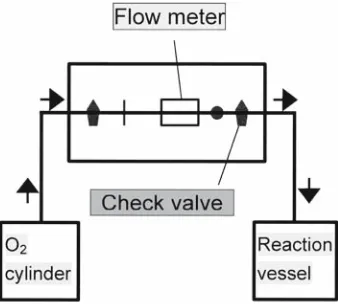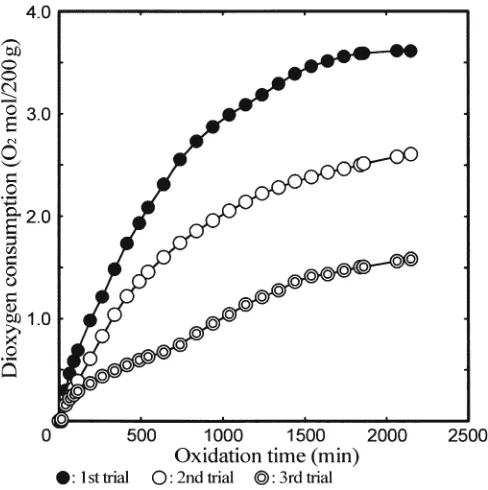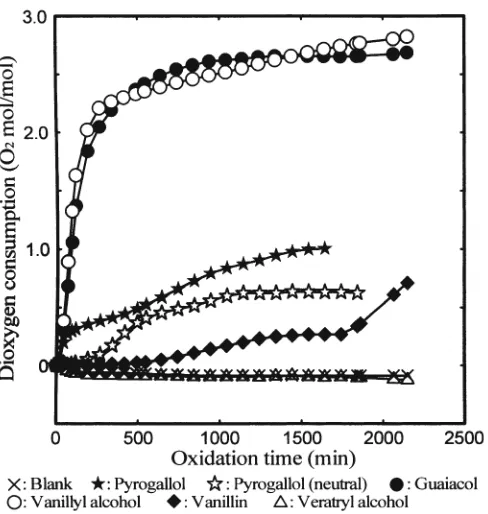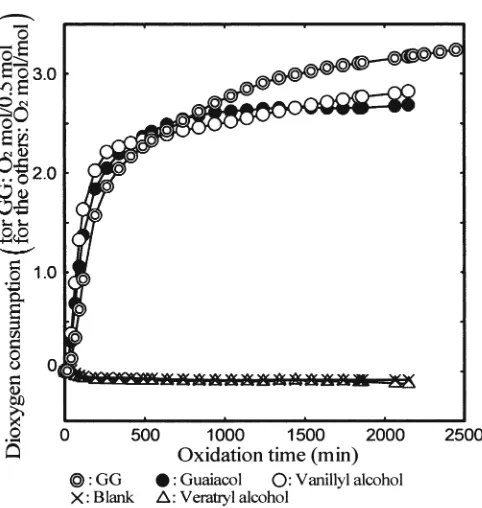Aiko Imai · Iori Tomoda · Tomoya Yokoyama Yuji Matsumoto · Gyosuke Meshitsuka · Guolin Tong
Application of the amount of oxygen consumption to the investigation of
the oxidation mechanism of lignin during oxygen-alkali treatment
Abstract The dioxygen consumption by kraft lignin and several lignin model compounds during oxygen-alkali treat-ments were directly analyzed using a dioxygen fl owmeter. The average dioxygen consumption by 200 g of kraft lignin was about 3 moles. Because this value was as much as those obtained for monomeric phenolic lignin model compounds, guaiacol and vanillyl alcohol, it was postulated that not only phenolic but also nonphenolic moieties in kraft lignin are extensively oxidized. The dioxygen consumption by 0.5 moles (one equivalent of aromatic units) of a dimeric lignin model compound, guaiacylglycerol-b-guaiacyl ether (GG), was also similar to that for 1 mole of guaiacol and vanillyl alcohol, regardless of the type of the aromatic moiety, which supports the above postulation. The most plausible mecha-nism for the oxidation of nonphenolic moieties is the oxida-tion of side chains of residual b-O-4 substructures by active oxygen species. By this mechanism, nonphenolic moieties in kraft lignin and GG are converted into correspond-ing phenolic moieties, and the oxidation by dioxygen progresses.
Key words Delignifi cation · Lignin · Oxidation · Oxygen bleaching · Phenolic
A. Imai · I. Tomoda · T. Yokoyama (*) · Y. Matsumoto · G. Meshitsuka
Laboratory of Wood Chemistry, Department of Biomaterial Sciences, Graduate School of Agricultural and Life Sciences, the University of Tokyo, 1-1-1 Yayoi, Bunkyo-ku, Tokyo 113-8657, Japan
Tel. +81-3-5841-5264; Fax +81-3-5802-8862 e-mail: yokoyama@woodchem.fp.a.u-tokyo.ac.jp
G. Tong
Department of Pulp and Paper Science, College of Chemical Engineering, Nanjing Forestry University, Nanjing 210037, China
Part of this article was presented at the 13th International Symposium on Wood, Fiber, and Pulping Chemistry (13th ISWFPC), Auckland, New Zealand, May 2005
Introduction
Oxygen-alkali bleaching plays an important role as pre-bleaching in elemental chlorine-free (ECF) and totally chlorine-free (TCF) bleaching sequences, and it is applied worldwide in the pulping industry.1 The progress of lignin oxidation during the bleaching affects the extent of deligni-fi cation. Tong and coworkers,2,3
for example, tried to estab-lish a correlation between the degree of lignin oxidation and delignifi cation. They applied an indirect method in which the correlation between the extent of lignin oxidation and the change in permanganate consumption by lignin before and after oxygen oxidation was examined. The change actu-ally represents an index for the progress of lignin oxidation and correlates well with the decrease of methoxyl group content in lignin. It was also shown that 200 g of kraft lignin consumes more than 2.2 moles of dioxygen.
Figure 1 shows typical major reaction products obtained by oxygen-alkali treatments of phenolic lignin model com-pounds.4,5
It is possible to calculate the amount of dioxygen consumed in affording 1 mole of these typical products based on the mechanisms for the formation of these prod-ucts. The results are no more than 1.5 moles of dioxygen as shown in Fig. 1. This value is smaller than that obtained for kraft lignin by Tong and coworkers, although kraft lignin consists of both phenolic and nonphenolic moieties and it has been well established that nonphenolic lignin model compounds do not react with dioxygen under conditions similar to oxygen-alkali bleaching.6
Therefore, it was postu-lated that the oxidation of nonphenolic moieties in kraft lignin is extensive.
63
oxygen pressure was adjusted to 0.8 MPa and the measure-ment of the dioxygen fl ow was begun.
Pyrogallol was also treated underneutral conditions. A control experiment was also conducted without adding any lignin sample.
The amounts of the substrates used were as follows: pyrogallol 0.625 g (9.9 mmol/l), guaiacol 0.625 g (10.1 mmol/l), vanillyl alcohol 0.48 g (6.2 mmol/l), vanillin 0.50 g (6.6 mmol/l), veratryl alcohol 0.48 g (5.7 mmol/l), GG 0.70 g (4.4 mmol/l), and kraft lignin 1.25, 0.625, or 0.313 g.
Results and discussion
In this study, the amount of dioxygen supplied to the reactor, which was measured by the fl owmeter shown Fig. 3, was converted into the amount of dioxygen consumed by 1 mole of the monomeric lignin model compounds, 200 g of kraft lignin, or 0.5 moles of GG. These values correspond to the dioxygen consumption by one equivalent of aromatic units. It was assumed in this calculation that all of the oxidation ability of dioxygen (four electron equivalents) was used to
Fig. 1. Major reaction products obtained by oxygen-alkali treatments
of phenolic lignin model compounds4,5 and the calculated oxygen con-sumption necessary for their formation
Fig. 2. Chemical structure of the model compounds used in this study.
GG, Guaiacylglycerol-b-guaiacyl ether moieties in kraft lignin and lignin model compounds are
extensively oxidized.
Materials and methods
Materials
Monomeric lignin model compounds, benzene-1,2,3-triol (pyrogallol), 2-methoxyphenol (guaiacol), methoxybenzyl alcohol (vanillyl alcohol), 4-hydroxy-3-methoxybenzaldehyde (vanillin), and 3,4-dimethoxybenzyl alcohol (veratryl alcohol), were purchased from Tokyo Chemical (Tokyo, Japan). Vanillyl alcohol and vanillin were recrystallized from ethanol. Guaiacol and veratryl alcohol were vacuum-distilled. Because pyrogallol is quite sensitive to dioxygen, it was not purifi ed. A dimeric lignin model compound, 1-(4-hydroxy-3-methoxyphenyl)-2-(2-methoxyphenoxy)propane-1,3-diol
(guaiacylglycerol-b-guaiacyl ether, GG), was synthesized according to the method of Li and coworkers.7
GG was purifi ed by prepara-tive medium-pressure liquid chromatography (YFLC-540, Yamazen, Osaka, Japan) on a silica gel column (Ultrapack SI-40C, Yamazen) by elution with chloroform/ethanol (10/1). The chemical structures of the compounds used in this study are shown in Fig. 2. Softwood kraft lignin was isolated by acidifying black liquor. The kraft lignin was thoroughly washed by water.
Oxygen-alkali treatment and measurement of dioxygen consumption
Figure 3 shows the scheme of the experimental design. Kraft lignin or a lignin model compound was dissolved into 500 ml of an aqueous solution containing 10 g of NaOH (0.5 mol/l), 10 ml of a 0.1% FeCl3 solution (0.36 mmol/l). The solution was transferred into a Tefl on-coated stainless steel reaction vessel and the vessel was sealed. The vessel was electrically heated to 95°C in 15 min under 0.6 MPa of oxygen pressure. As soon as temperature reached 95°C, the
oxidize organic substances in the reactor. This assumption is incorrect only when peroxides produced in the system are stable enough to accumulate. Because it has been reported that the amount of such peroxides is very small under condi-tions similar to those in this study,8 the assumption can be considered to be always correct. In the case of kraft lignin experiments, because kraft lignin contains some unknown organic substances, sulfur-related compounds, and some structures that are different from common lignin, the amount calculated for 200 g of kraft lignin does not exactly corre-spond to one equivalent of aromatic units in kraft lignin. However, the experiments for kraft lignin can still be very helpful to discuss the dioxygen consumption by lignin.
Figures 4, 5, and 6 show the amount of dioxygen con-sumption by 200 g of kraft lignin when the amount of kraft lignin treated was 1.25, 0.625, or 0.313 g, respectively. It is noticed that the variation of the data is greater when the concentration of kraft lignin is lower. When the smallest amount of kraft lignin was subjected to the reaction, the dioxygen supply was the smallest. An amount of dioxygen had already existed in the reactor before the reaction was initiated. When this amount is not signifi cantly smaller than that supplied to the reaction vessel during the reaction, the data variation is signifi cant. As a result, all data used in subsequent analysis were obtained when the dioxygen con-sumption was considered to be suffi ciently high.
Oxygen-alkali treatment of monomeric lignin model compounds
Figure 7 illustrates the amount of dioxygen consumed by 1 mole of the monomeric lignin model compounds. The amount of dioxygen consumed by pyrogallol under alkaline
conditions was 1.7 times that consumed under neutral con-ditions. Two mechanisms for the pyrogallol oxidation are conceivable: one via an ortho-quinone derivative and the other via a ring-opening step. The ortho-quinone derivative is rearomatized by the addition of hydroxide anion and further oxidized by dioxygen. The product of the ring-opening step reacts directly with dioxygen to afford two
Fig. 4. Dioxygen consumption by kraft lignin measured by the
dioxy-gen fl owmeter for an initial amount of kraft lignin of 1.25 g
Fig. 5. Dioxygen consumption by kraft lignin measured by the
dioxy-gen fl owmeter for an initial amount of kraft lignin of 0.625 g
Fig. 6. Dioxygen consumption by kraft lignin measured by the
65
dicarboxylic acids. On the other hand, both primary degra-dation products are relatively unreactive toward dioxygen under neutral conditions. Because these possible reaction mechanisms for the degradation of pyrogallol by dioxygen can be elucidated based on the amount of dioxygen used, the actual reaction mechanism that occurs can be assigned based on the amount of dioxygen measured by the fl owme-ter in the experiment.
One mole of guaiacol or vanillyl alcohol, both of which contain phenolic hydroxyl and methoxyl groups, continu-ously consumed about 3 moles of dioxygen (Fig. 7). As mentioned in the Introduction, it is estimated that 1 mole of phenolic lignin model compound consumes no more than 1.5 moles of dioxygen to give typical degradation products (Fig. 1). This value is smaller than the dioxygen consump-tion by guaiacol and vanillyl alcohol obtained in this study. It should also be noted that 1 mole of guaiacol or vanillyl alcohol rapidly consumes more than 2 moles of dioxygen within 250 min. Based on these results, it is suggested that possible primary degradation products of these model com-pounds, such as muconic acid derivatives, are continuously oxidized by dioxygen to give further degradation products under the conditions employed.
It has been well established that vanillin, a monomeric phenolic lignin model compound with an a-carbonyl group, and veratryl alcohol, a monomeric nonphenolic lignin model compound, do not react with dioxygen without adding any other compound that can react with dioxygen.6
The amounts of dioxygen consumption by vanillin and veratryl alcohol obtained in this study were also very small.
Oxygen-alkali treatment of kraft lignin
The average dioxygen consumption per 200 g of kraft lignin was about 3 moles (Fig. 4). This value is approximately the same as that obtained for 1 mole of the monomeric phenolic lignin model compounds, guaiacol and vanillyl alcohol. Aromatic nuclei in kraft lignin consist of phenolic and nonphenolic types. To rationally explain the high dioxygen consumption by kraft lignin, it is postulated that extensive oxidations occur not only on phenolic but also on nonphenolic moieties in kraft lignin. However, as men-tioned in the previous section, it has been well established and also observed in this study that nonphenolic lignin model compounds, such as veratryl alcohol, do not consume dioxygen without adding any other compound that reacts and consumes dioxygen. Furthermore, Tong and co-workers2
reported that the extent of the oxidation of vera-tryl alcohol is small when the compound is subjected to oxygen-alkali treatment with a phenolic lignin model com-pound like vanillyl alcohol. This observation indicates that nonphenolic aromatic moieties are not extensively oxidized by the actions of active oxygen species generated by the reactions between vanillyl alcohol and dioxygen. Hence, it is necessary to consider mechanisms in which nonphenolic moieties are converted into phenolic ones. Two possible mechanisms are conceivable: (1) hydroxylation of nonphe-nolic moieties and (2) oxidative degradation of side-chain portions that are connected to aromatic moieties via alkyl– aryl ether bonds. However, the former is not likely, because the extent of veratryl alcohol oxidation is signifi cantly smaller than that of vanillyl alcohol when these compounds are subjected together to an oxygen-alkali treatment as described above.2
If the nonphenolic moiety of veratryl alcohol is hydroxylated, the extent of the oxidation of the compound should become similar to that of vanillyl alcohol. Therefore, the oxidative degradation of side-chain portions is more plausible. The most reasonable reaction is the oxi-dative degradation of side-chain portions of remaining b -O-4 structures to afford new phenolic moieties. If this is the case, veratryl alcohol may be inappropriate as a nonpheno-lic lignin model compound because the methyl group of veratryl alcohol, which is supposed to be a model for the side-chain portion, is not oxidized and a phenolic compound is not generated from veratryl alcohol.
The oxidative degradation of side chains is probably caused by active oxygen species, such as hydroxyl radical, generated by the oxidation of phenolic moieties by dioxy-gen. From this point of view, these active oxygen species play a very important role in the progress of lignin oxida-tion. This oxidation mechanism is similar to the oxidative degradation of carbohydrate model compounds when sub-jected to oxygen-alkali treatments together with phenolic compounds.9–11 Several literatures report that the consump-tion of dioxygen by lignin samples is similar to or larger than those obtained in this study.12–17
Fig. 7. Dioxygen consumption by monomeric lignin model compounds
Oxygen-alkali treatment of GG
To further examine whether nonphenolic moieties are converted into phenolic moieties during the oxidation by dioxygen, the amount of dioxygen consumed by GG was determined. GG is a dimeric b-O-4 lignin model compound and has both phenolic and nonphenolic moieties. It was observed that 3 moles of dioxygen are consumed by one equivalent of aromatic units (0.5 moles) of GG, regardless of the type of aromatic moieties (Fig. 8). This value is a little greater than those of the monomeric phenolic lignin model compounds, guaiacol and vanillyl alcohol. If the nonpheno-lic aromatic moiety in GG is supposed not to be extensively oxidized, the phenolic moiety in GG has to consume almost 6 moles of dioxygen although this moiety resembles guaia-col and vanillyl alcohol. Therefore, it is presumed that the side chain of GG is oxidized by active oxygen species and the nonphenolic moiety is converted into the corresponding phenolic moiety (guaiacol), followed by the oxidative deg-radation of the new phenolic moiety. The observation that the dioxygen consumption by 0.5 moles of GG is a little larger than that consumed by 1 mole of guaiacol or vanillyl alcohol may indicate the dioxygen consumption by the side chain of GG.
The release of guaiacol from GG can also be attained without the action of active oxygen species, when the enol ether, 1-(4-hydroxy-3-methoxyphenyl)-2-(2-methoxypheno-xyethylene, forms and is oxidized by dioxygen. The enol ether is produced from the quinone methide derived from GG followed by the release of the g-carbon as formalde-hyde. However, because it is known that the conditions employed in this study are not suffi cient to frequently give the quinine methide from GG,18
the release of guaiacol from GG must result from the action of active oxygen species.
The mechanism of lignin oxidation was confi med to be elu-cidated by the amount of dioxygen consumption, which was measured by a dioxygen fl owmeter in this study. The obser-vation that the dioxygen consumption by 200 g of kraft lignin and by guaiacol or vanillyl alcohol was similar has led us to postulate that phenolic and nonphenolic moieties in kraft lignin are extensively oxidized. This postulatoin was sup-ported by the dioxygen consumption by 0.5 moles of GG (an equivalent of aromatic unit), which was larger than the diox-ygen consumption of 1 mole of guaiacol or vanillyl alcohol. The most plausible mechanism for the extensive oxidation of nonphenolic moieties in kraft lignin and GG is the oxidative cleavage of alkyl–aryl ethers by active oxygen species, a process that converts nonphenolics into phenolic moieties.
Acknowledgments The authors gratefully acknowledge fi nancial
support from the Ministry of Education, Culture, Sports, Science, and Technology of Japan [Grant-in-Aid for Young Scientists (B), No.17780136].
References
1. Chen C-L (1991) Lignin – occurrence in woody tissues, isolation, reactions, and structure. In: Levin M, Goldstein IS (eds) Wood structure and composition. Marcel Dekker, New York, pp 183–261
2. Tong G, Yokoyama T, Matsumoto Y, Meshitsuka G (2000) Analy-sis of progress of oxidation reaction during oxygen-alkali treatment of lignin 1: method and its application to lignin oxidation. J Wood Sci 46:32–39
3. Tong G, Matsumoto Y, Meshitsuka G (2000) Analysis of progress of oxidation reaction during oxygen-alkali treatment of lignin 2: signifi cance of oxidation reaction of lignin during oxygen deligni-fi cation. J Wood Sci 46:371–375
4. Eckert RC, Chang H-M, Tucker WP (1973) Oxidative degradation of phenolic lignin model compounds with oxygen and alkali. TAPPI 56:134–138
5. Gierer J, Imsgard F (1977) Studies on the autoxidation of t-butyl-substituted phenols in alkaline media 1: reaction of 4-t-butylguaia-col. Acta Chem Scand B31:537–545
6. Johansson E, Ljunggren S (1994) The kinetics of lignin reactions during oxygen bleaching part 4: the reactivities of different lignin model compounds and the infl uence of metal ions on the rate of degradation. J Wood Chem Technol 14:507–525
7. Li S, Lundquist K, Paulsson M (1995) Synthesis of guaiacylglyc-erol-b-guaiacyl ether. Acta Chem Scand 49:623–624
8. Yokoyama T, Matsumoto Y, Meshitsuka G (1999) The role of peroxide species in carbohydrate degradation during oxygen bleaching III: effect of metal ions on the reaction selectivity between lignin and carbohydrate model compounds. J Pulp Pap Sci 22:J151–J154
9. Yokoyama T, Matsumoto Y, Yasumoto M, Meshitsuka G (1996) The role of peroxide species in carbohydrate degradation during oxygen bleaching II: effect of oxygen pressure on the degradation of lignin and carbohydrate model compounds and on the reaction selectivity. J Pulp Pap Sci 22:J151–J154
10. Yokoyama T, Matsumoto Y, Meshitsuka G (1999) Reaction selec-tivity of active oxygen species in oxygen-alkali bleaching. J Wood Chem Technol 19:187–202
11. Yokoyama T, Matsumoto Y, Meshitsuka G (2005) Characteriza-tion of active oxygen species under oxygen-alkali bleaching condi-tions. Holzforschung 59:269–275
12. Lautsch W, Plankenhorn E, Klink F (1940) Über die bildung des vanillins aus dem holz, dem lignin und der sulfi tcelluloseablauge der fi chte. Angew Chem 53:450–452
Fig. 8. Dioxygen consumption by GG and the monomeric phenolic
67
13. Deineko IP, Nikol’skii SN, Zarubin MY (1983) Quantitative deter-mination of oxygen consumption in oxygen pulping. Khimiya Drevesiny 1983:54–57
14. Capanema EA, Balakshin MY, Chen C-L, Gratzl JS, Kirkman AG (2001) Oxidative ammonolysis of technical lignins part 1: kinetics of the reaction under isothermal conditions at 130°C. Holzforsc-hung 55:397–404
15. Capanema EA, Balakshin MY, Chen C-L, Gratzl JS, Kirkman AG (2001) Oxidative ammonolysis of technical lignins part 2: effect of oxygen pressure. Holzforschung 55:405–412
16. Capanema EA, Balakshin MY, Chen C-L, Gratzl JS, Kirkman AG (2002) Oxidative ammonolysis of technical lignins part 3: effect of temperature on the reaction rate. J Wood Chem Technol 26:5–20 17. Capanema EA, Balakshin MY, Chen C-L, Gratzl JS (2006)
Oxidative ammonolysis of technical lignins part 4: effects of the ammonium hydroxide concentration and pH. Holzforschung 56:402–415



